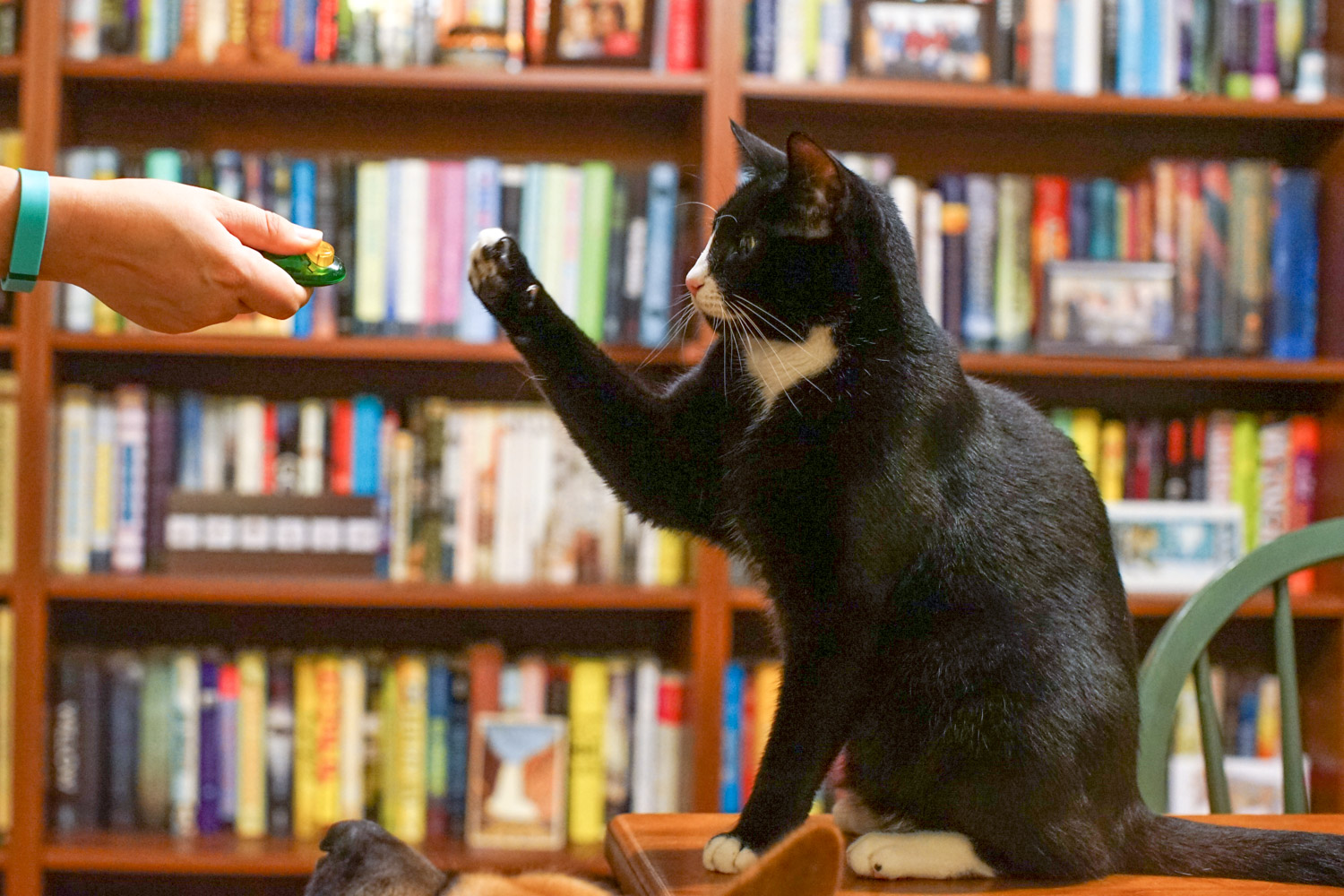Clicker training is a rewarding and effective way to teach your cat desired behaviors. It involves using a small, handheld device that makes a clicking sound to mark the exact moment your cat performs a desired action. This positive reinforcement helps your cat understand what you want them to do and encourages them to repeat the behavior.
In this guide, we’ll explore the basics of clicker training, including the different types of clickers, targeting, basic commands, shaping, and troubleshooting common issues.
Whether you’re looking to improve your cat’s manners, solve behavioral problems, or simply enrich their life with new activities, clicker training is a versatile and enjoyable tool that can help you achieve your goals.
Introduction
Clicker training is a positive reinforcement technique that uses a clicker to mark the exact moment a cat performs a desired behavior. This method is highly effective in shaping behaviors, as it allows precise and timely rewards, enhancing the cat’s understanding of what is expected.
The steps involved in clicker training include:
- Introducing the clicker and associating it with a reward.
- Identifying and isolating the desired behavior.
- Clicking the clicker immediately after the behavior occurs.
- Rewarding the cat with a treat or praise.
Types of Clickers
Clickers come in a variety of shapes, sizes, and styles, each with its own advantages and disadvantages for use with cats. The most common types of clickers are:
- Basic clickers: These are the most affordable and widely available type of clicker. They typically consist of a small plastic box with a metal tongue that, when pressed, produces a sharp clicking sound.
- Target clickers: These clickers are similar to basic clickers, but they have a small target attached to the end of the tongue. This makes it easier to aim the clicker at the cat, which can be helpful when training them to perform specific behaviors.
- Electronic clickers: These clickers use a battery to produce a clicking sound. They are often more expensive than basic clickers, but they offer some advantages, such as the ability to adjust the volume of the click and to record and playback custom sounds.
Targeting and Basic s
Targeting is a fundamental skill in clicker training that establishes a reliable way for your cat to communicate with you. By targeting, your cat learns to touch a specific object (a target stick) with its nose, allowing you to mark and reward desired behaviors precisely.
Teaching Targeting
- Hold the target stick near your cat’s nose and wait for it to show interest.
- When your cat touches the stick, click immediately and give a treat.
- Repeat steps 1-2 several times, gradually increasing the distance between the stick and your cat.
- Once your cat reliably targets the stick at a distance, you can start using it as a cue for other behaviors.
Basic s Using Clicker Training
In addition to targeting, several basic s can be taught using clicker training:
-
-*Sit
Lure your cat into a sitting position with a treat and click/reward when its bottom touches the ground.
-*Stay
Once your cat can sit, gradually increase the duration it stays in position while you move away. Click/reward when it maintains the “stay” for the desired duration.
-*Come
Hold a treat in front of your cat and move backward while saying “come.” When your cat follows, click/reward. Gradually increase the distance and distraction level.
Shaping and Advanced Behaviors

Shaping is a technique used in clicker training to gradually develop complex behaviors by rewarding successive approximations of the desired outcome.
To shape a behavior, start by rewarding the cat for any small step towards the desired goal. As the cat becomes more consistent, gradually increase the criteria for the reward until the desired behavior is achieved.
Examples of Shaping Complex Behaviors
- Jumping through a hoop: Start by rewarding the cat for simply touching the hoop, then gradually increase the distance and height of the jump.
- Fetching: Begin by rewarding the cat for picking up an object, then gradually increase the distance the cat must carry it and the type of object it must fetch.
Troubleshooting and Common Issues

Clicker training with cats, while rewarding, can present some challenges. Here are some common issues and their solutions:
Lack of Interest or Engagement
If your cat shows disinterest, start with high-value treats and keep training sessions short and engaging. Use a variety of treats and toys to maintain motivation.
Confusion or Misinterpretation
Ensure clear and consistent cues. Avoid using multiple commands or gestures simultaneously, as this can confuse the cat. Use a distinct click sound and associate it with the desired behavior.
Over-Rewarding or Punishment
Reward only when the desired behavior is performed. Avoid over-treating, as it can lead to satiation and reduced motivation. Similarly, avoid punishment, as it can damage the bond and make the cat fearful.
Difficulty with Timing
Click within a second of the desired behavior to create a strong association. If you’re too slow, the cat may not understand the connection between the behavior and the reward.
Regression or Plateaus
If the cat stops responding or plateaus in progress, review your training methods and ensure consistency. Introduce new challenges gradually to keep the cat engaged and motivated.
Enrichment and Applications
Clicker training offers numerous enrichment opportunities for cats. It provides mental stimulation, allows them to engage in desired behaviors, and strengthens the bond between cats and their owners.
Clicker training can be used to solve behavioral problems, such as scratching furniture, jumping on counters, or aggression. By rewarding cats for appropriate behaviors, owners can redirect their energy and create a more harmonious environment.
Training for Special Needs Cats
Clicker training is particularly beneficial for cats with special needs. For instance, it can help blind or deaf cats navigate their surroundings by rewarding them for specific sounds or hand gestures.
Closing Summary
With patience, consistency, and a positive attitude, clicker training can be a transformative experience for both you and your cat. It’s a fun and rewarding way to build a stronger bond with your furry friend while teaching them valuable skills that will enhance their quality of life.
Helpful Answers
What are the benefits of clicker training for cats?
Clicker training can help cats learn new behaviors quickly and effectively, improve their focus and attention, reduce problem behaviors, strengthen the bond between you and your cat, and provide mental and physical stimulation.
What types of clickers are available?
There are two main types of clickers: mechanical and electronic. Mechanical clickers make a clicking sound when you press a button, while electronic clickers emit a variety of sounds, including clicks, whistles, and tones.
How do I teach my cat to target?
Start by holding the clicker in one hand and a treat in the other. Hold the treat in front of your cat’s nose and slowly move it back towards their body. As soon as your cat’s nose touches the target, click the clicker and give them the treat.
Repeat this process several times until your cat consistently touches the target when you present it.
What are some basic commands that I can teach my cat using clicker training?
Some basic commands that you can teach your cat using clicker training include sit, stay, come, shake, and high five.
How do I troubleshoot common issues that I may encounter during clicker training?
Some common issues that you may encounter during clicker training include your cat not responding to the clicker, getting distracted, or becoming frustrated. If you encounter any of these issues, try to identify the cause and adjust your training accordingly.




